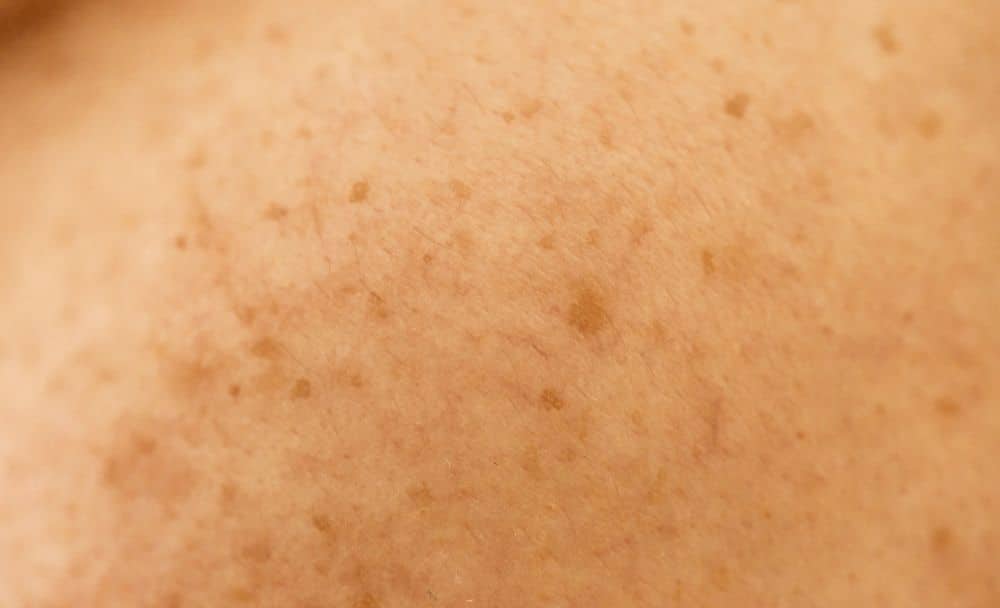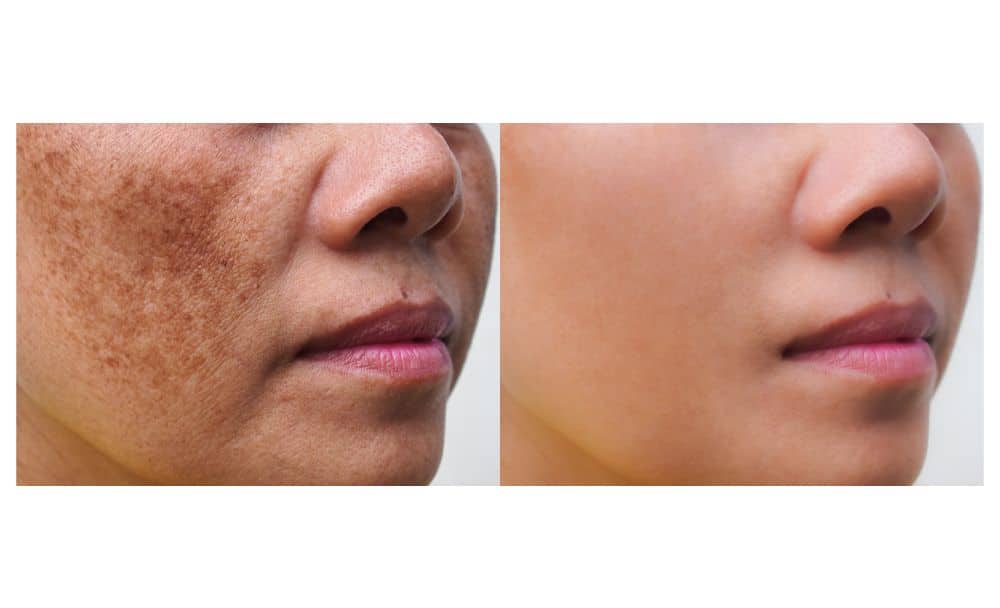Reviewed By Dr. Vipin Bihari Sharma
Melasma, a common skin issue, affects many individuals, particularly women with darker skin tones. The skin condition consists of brown or grayish-brown patches, primarily on sun-exposed areas such as melasma on face, particularly the chin, cheeks, forehead, upper lip area, and occasionally the neck and forearms. [1] This condition is more common among individuals of Hispanic, Oriental, and Asian origin and is prevalent in women, especially during their reproductive years. To understand what is melasma, one needs to look at the various factors that lead to this condition, including genetic and hormonal as well as ingredients in cosmetics, exposure to ultraviolet radiation, anti-seizure and phototoxic drugs, nutritional deficiency, and hepatic dysfunction, among others. [2]
While Melasma is not harmful or contagious, it can cause significant cosmetic concerns and affect one’s self-esteem, quality of life, social and emotional well-being, and overall physical health. Understanding the symptoms, melasma causes, diagnosis, melasma treatment, and prevention methods associated with Melasma is essential for effectively managing this condition and achieving healthier, more even-toned skin. In this article, we will focus on the melisma meaning, and its various aspects, providing valuable insights into its nature, factors contributing to its development, methods of diagnosis, the best treatment for Melasma on face, and preventive measures that can help minimize its impact on one’s skin. By increasing awareness and knowledge about melasma meaning, individuals can take proactive steps toward managing and reducing its appearance, leading to improved skin health and overall well-being.
What are the symptoms of Melasma?
Some of the symptoms that indicate the prevalence of melasma include:
- Patchy, irregular brown or grayish-brown patches on the face, primarily on sun-exposed areas
- Symmetrical distribution of patches on both sides of the face
- Patches may darken upon sun exposure, aggravate during the summer, and fade in the winter.
- The affected skin may appear slightly raised or have a rough texture. [2]
What are the causes of Melasma?
The exact melasma causes are not known, but several factors contribute to its development:
Sun exposure:
Ultraviolet (UV) radiation of the sun stimulates melanin production, the pigment responsible for skin color. Overexposure to the sun can worsen melasma on face.
Hormonal changes:
Melasma on face is often associated with hormonal fluctuations, such as during pregnancy (chloasma) or in those women who use estrogen-progesterone oral contraceptives and undergo hormone replacement therapy to prevent osteoporosis. It is also seen in women who are in their postmenopausal stage. In some cases, it is seen in men who use estrogen derivatives to treat prostatic cancer.
Genetic predisposition:
A genetic component may make some individuals more susceptible to developing Melasma. [2]
Endocrinological factors:
It has been seen that an increase in the level of luteinizing hormone and a decrease in the level of serum estradiol in people cause melasma. [3]
Other factors:
Certain medications, cosmetics, nutritional deficiency, and skincare products, as well as ovarian or thyroid dysfunction, may trigger or exacerbate Melasma in some cases. [2]
How can melasma be diagnosed?
A dermatologist can diagnose Melasma by physically examining the affected skin. In some cases, a Wood’s lamp (a special ultraviolet light) may be used to examine the skin more closely and determine the depth of the pigmentation. With the help of the Wood’s Light examination, a doctor can also classify Melasma into four major clinical types that indicate the depth of melanin pigments. These are:
Epidermal melasma:
This is pale brown, and the contrast is further enhanced during Wood’s light examination.
Dermal melasma:
Here, the skin appears brown or bluish-gray in visible light, and under Wood’s light, it seems to have less distinct borders that have no enhancement of pigmentation.
Mixed melasma:
The skin seems to be dark brown with the enhancement of pigmentation as is visible under Wood’s light in certain areas, but not in all.
Indeterminate or unapparent melasma:
This is more common in individuals with dark-brown skin.
Based on three variables, a medical practitioner assesses the severity of melasma in all the common areas affected by it, including the forehead, right malar region, left malar region, and chin. These are homogeneity, darkness, and the percentage of the affected area. [2]
How can melasma be treated?
Although Melasma cannot be cured completely, several melasma treatment options can help manage the condition. These aim at alleviating already existing pigmentation and preventing new pigmentation. Melasma treatment depends on the type of melasma, the expectations of the patient, and how effective previous treatments have been. Some of the melasma treatment options available include:
Sun protection:
Wearing broad-spectrum sunscreen (SPF 30 or higher) and protective clothing, such as wide-brimmed hats and sunglasses, can help prevent the worsening of Melasma.
Use of bleaching agents:
This treatment method involves using chemical substances to lighten the color of the skin and get a more even-toned complexion.
Topical medications:
Dermatologists often prescribe hydroquinone, tretinoin, corticosteroids, melasma treatment creams, or a combination of these ingredients to lighten the patches over time.
Procedures:
Procedures like chemical peels, microdermabrasion, and laser therapy can help improve Melasma by removing the top layers of skin and promoting skin rejuvenation.
Laser and light therapies:
This works well on light-skinned people, and various lasers can be advantageous for dermal Melasma.
Combination therapy:
Also, a combination of topical medications, melasma treatment creams, and procedures may be recommended for more effective results. [2]
How can melasma be prevented?
To prevent Melasma or minimize its severity:
Use sunscreen regularly to shield your skin against the sun’s rays.
Wear wide-brimmed hats and sunglasses, and use an umbrella to provide additional sun protection.
Avoid excessive sun exposure, especially during peak hours.
Self-treatment of melisma is not recommended. You must consult a dermatologist for an accurate diagnosis and personalized treatment plan based on the specific condition and to avoid complications.[3]
FAQs
- What are a few of the home remedies for melasma?
There are several methods for melasma treatment at home, such as using an Aloe Vera gel to rehydrate dry skin. Other forms of melasma treatment at home include lemon juice, black tea, tomato, and turmeric.
- How to cure Melasma from the inside through Ayurveda?
Melasma is correlated to Vyanga in Ayurveda and is said to occur due to a variation of vata and pitta. This results in neeruja, tanu, shyama, and mandalanvita, which refer to painless, thin, bluish-black, brown, and circular patches. Among the best treatment for Melasma on face through Ayurveda are:
- Siravyadha: a kind of blood-letting treatment
- Pralepa: application of external creams and ointments
- Abhyanga: facial massages with certain oils
- Nasyakarma: nasal drops to let out toxins
- Rakta shodhaka: oral medication for blood purification
- What is the fastest and best treatment for Melasma on face?
Sun protection is the best treatment for melisma. Apart from sun protection, taking Vitamin B12 and iron supplements may also help.
Conclusion
Melasma is a common skin condition and can be effectively managed by following these preventive measures and seeking appropriate treatment. In this article, we have discussed melasma meaning, the best melasma treatment options, and how to diagnose melasma on face, all of which can help achieve healthier, more even-toned skin. Consulting with a dermatologist is essential for an accurate diagnosis and personalized treatment plan that suits individual needs. With proper care and attention, individuals can minimize the impact of Melasma and regain their confidence in their skin’s appearance.
Disclaimer:
This article is written from a health and wellness perspective and is not medical advice. Kindly seek the help of a certified medical practitioner before initiating any treatment.



















